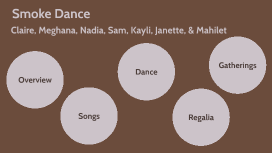SMOKE SIGNALS PRESENTATION
Transcript: This quote sheds light on how media in the United States wrongly portrays Native American peoples and how they have been reduced to a caricature in the past. Examples include Native American portrayal in movie Peter Pan, Native American images in sports teams, use of Native American imagery for Halloween and costumes etc. There is a dark and twisted irony in the fact that Native American peoples, who live on lands primarily controlled by the US government, can watch American movies that portray their people as savages. Smoke Signals recognizes this, and in a very brief but powerful scene manages to illustrate what it feels like as a Native American watching these and knowing that they are largely inaccurate. - The film also demonstrates trust issues that are shared by many Native Americans, which are products of violated treaties and legal agreements. - In our opinion, issues between Native Americans and the federal government stem from the fact that most, if not all, treaties between indigenous groups and the U.S. government have been broken. - Although reservations and Native nations are advertised as having sovereignty, the reality is that the Native American peoples are not really free to the extent promised. - "Plenary Power," by Congress claims exclusive and total authority over Native American lands and resources. With systems like this in place, what "Indian" would want to sign a treaty? Austine Delos Santos | Cameron Gurley | Ricardo Alejandro Gustavson | Adrian Gaudia | Ken Soto Hashimoto Dark humor is used in the movie to explore the tragic issues that are rooted in Native American culture. With references to the Oral tradition, John Wayne, treaty signing, and the disease brought by the Europeans, Smoke Signals, effectively incorporates humor as a means of communication to express the Native Americans' sentiments over their history and present conditions. Not only have Native Americans lost trust because of broken treaties, but also because of various laws that have promised equality and have not delivered. Alluding to tragic historical events such as the deadly diseases that Europeans brought to the Americas, the film is able to briefly mention a genocidal part of our nation's past in this humorous encounter. Witty dialogue effectively weaves in commentaries on Native Americans' social and historical struggles in a seemingly ordinary conversation. This scene also highlights the idea that the US outside of reservations are no longer considered "home" by Native Americans, further reinforcing the conflict between Native Americans and the rest of the US. The comic below shows a humorous, hypothetical view towards what "could have been" when the Pilgrims were trying to immigrate to North America and leave their "reservations" across the Atlantic. Today, many Native Americans are forced to assimilate although they have their own cultural practices, languages, and education. As we have learned from history, the United States federal government has made and broken over 400 treaties. One specific example is the Treaty of Canandaigua, which was later violated by the US for ulterior economic motives. The treaty promised that after the Revolutionary War, the US would return more than a million acres of land back to the Haudenosaunee. Over the years, however, this territory has been stolen from the Haudenosaunee. The only provision that the US has not violated is Article 6, which "says that they will provide goods in the amount of $4,500, 'which shall be expended yearly forever.' " Humorous accounts of the ongoing struggles between Native Americans and the non-natives are not limited to the movie but go beyond the boundaries of film with examples in political cartoons. As seen in the cartoon above, it can be shown that this example of "honoring" the Native Americans is obviously racial stereotypes. It is funny in the fact that the non-native on the right looks completely ridiculous for trying to "honor" the Native American by donning a head dress, native american logos, and writing "go savages" on himself, however, it also alludes to this idea that the true savage of the pair are the non-natives themselves. "Trust takes years to build, seconds to break, and forever to repair." Canadian Bill c-31 This Bill amended the Canadian Indian Act of 1985, which stripped Indian women of their status if they married non Indians. The Bill returned status to the women and children that lost status due to the Act, but the Bill simply replaced this discrimination with something worse. The Bill created two classes of Indians. Six-one (fullblood) and six-two (half Indian, half non Indian). When a six-two married another or a non Indian their children lost status. Within two generations status could disappear and eventually make Indians go extinct. With legislation like Bill c-31 it is easy to see how Indians have trouble trusting the government. CITATIONS Through Western media and an imperialist perspective, Native American

















